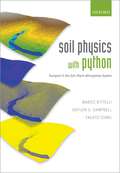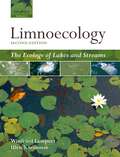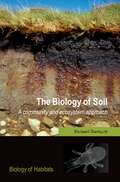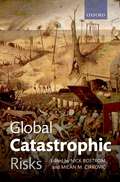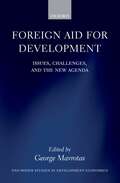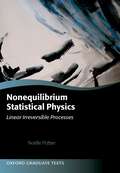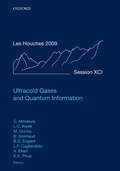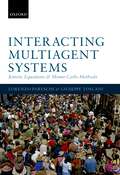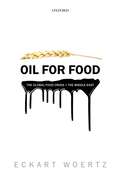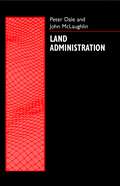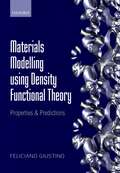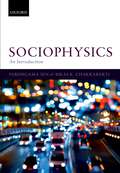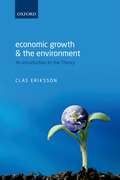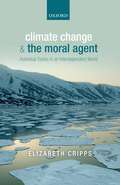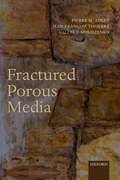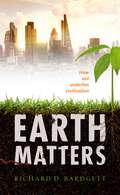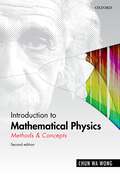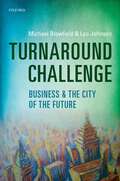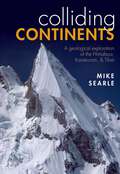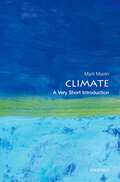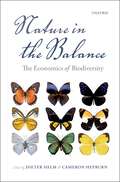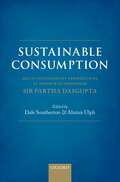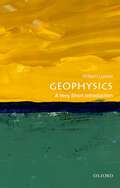- Table View
- List View
Soil Physics with Python: Transport in the Soil-Plant-Atmosphere System
by Marco Bittelli Gaylon S. Campbell Fausto TomeiThis innovative study presents concepts and problems in soil physics, and provides solutions using original computer programs. It provides a close examination of physical environments of soil, including an analysis of the movement of heat, water and gases. The authors employ the programming language Python, which is now widely used for numerical problem solving in the sciences. In contrast to the majority of the literature on soil physics, this text focuses on solving, not deriving, differential equations for transport. Using numerical procedures to solve differential equations allows the solution of quite difficult problems with fairly simple mathematical tools. Numerical methods convert differential into algebraic equations, which can be solved using conventional methods of linear algebra. Each chapter introduces a soil physics concept, and proceeds to develop computer programs to solve the equations and illustrate the points made in the discussion. Problems at the end of each chapter help the reader practise using the concepts introduced. The text is suitable for advanced undergraduates, graduates and researchers of soil physics. It employs an open source philosophy where computer code is presented, explained and discussed, and provides the reader with a full understanding of the solutions. Once mastered, the code can be adapted and expanded for the user's own models, fostering further developments. The Python tools provide a simple syntax, Object Oriented Programming techniques, powerful mathematical and numerical tools, and a user friendly environment.
Limnoecology: The Ecology of Lakes and Streams
by Winfried Lampert Ulrich SommerThis concise, readable introduction to limnology (the science of investigating the structure and function of inland waters), places the subject in the context of modern ecology. Unlike most ecological textbooks, which use examples taken almost exclusively from terrestrial systems, this book integrates the fields of limnology and ecology by presenting empirical data drawn entirely from freshwater ecosystems in order to advance ecological theories (limnoecology). This second edition builds upon the strengths of the first with the structure of the book following the same hierarchical concept of ecology, from habitat properties, individuals, populations, coupled populations and communities to ecosystems. However, it has been thoroughly revised throughout to incorporate findings from new technologies and methods (notably the rapid development of molecular genetic methods and stable isotope techniques) that have allowed a rapid and ongoing development of the field. There is a new emphasis on food webs, species diversity and ecosystem functioning, climate change, and conservation management. Key ecological questions are examined in the light of the latest experimental evidence. Throughout the text evolutionary theory is applied to an understanding of freshwater ecosystems, thereby filling a niche between traditional limnology and evolutionary ecology. This accessible text is suitable for both undergraduate and graduate students taking courses in limnology, freshwater ecology, and aquatic biology as well as the many professional limnologists, ecologists and conservation biologists requiring a concise but authoritative overview of the topic
The Biology of Soil: A community and ecosystem approach (Biology of Habitats)
by Richard BardgettThis book is unique in providing a comprehensive, up-to-date synthesis of what is known about soil biodiversity and the factors that regulate its distribution, as well as the functional significance of below-ground biodiversity for ecosystem form and function. It describes the vast diversity of biota that live in the soil environment - the most complex habitat on Earth - and discusses the factors that act as determinants of this diversity across different spatial and temporal scales. The Biology of Soil also considers how biotic interactions in soil influence the important soil processes of decomposition and nutrient cycling . It demonstrates how interactions and feedbacks between diverse plant and soil communities act as important drivers of ecosystem form and function. The importance of these relationships for understanding how ecosystems respond to global change phenomena, including climate change, is discussed in depth. Much is still to be learned about the soil biota and their roles in ecosystems, and the author highlights some of the many challenges that face ecologists in the exploration of soil. Richard Bardgett has wide experience in soil and terrestrial ecology, and his background of research in many ecosystems is reflected in this book which is the most comprehensive, up-to-date volume currently available in soil ecology. It provides an introduction to the biology of soil, and it also discusses the most recent developments in this progressive field of ecology. The importance of soil biotic interactions for community and ecosystem ecology is illustrated through the use of numerous examples and case studies. The Biology of Soil provides an excellent, easy to read introduction for anyone working in the field of soil ecology and related disciplines, and will be ideal for students taking undergraduate and postgraduate courses in soil ecology, plant-soil relationships, ecosystem ecology, and land management.
Global Catastrophic Risks
A global catastrophic risk is one with the potential to wreak death and destruction on a global scale. In human history, wars and plagues have done so on more than one occasion, and misguided ideologies and totalitarian regimes have darkened an entire era or a region. Advances in technology are adding dangers of a new kind. It could happen again. In Global Catastrophic Risks 25 leading experts look at the gravest risks facing humanity in the 21st century, including asteroid impacts, gamma-ray bursts, Earth-based natural catastrophes, nuclear war, terrorism, global warming, biological weapons, totalitarianism, advanced nanotechnology, general artificial intelligence, and social collapse. The book also addresses over-arching issues - policy responses and methods for predicting and managing catastrophes. This is invaluable reading for anyone interested in the big issues of our time; for students focusing on science, society, technology, and public policy; and for academics, policy-makers, and professionals working in these acutely important fields.
Foreign Aid for Development: Issues, Challenges, and the New Agenda (WIDER Studies in Development Economics)
Foreign aid is one of the few topics in the development discourse with such an uninterrupted, yet volatile history in terms of interest and attention from academics, policymakers, and practitioners alike. Does aid work in promoting growth and reducing poverty in the developing world? Will a new 'big push' approach accelerate progress towards the Millennium Development Goals or will another opportunity be missed? Can the lessons of almost half a century of aid giving be learnt? These are truly important questions in view of the emerging new landscape in foreign aid and recent developments related to the global financial crisis, which are expected to have far reaching implications for both donors and recipients engaged in this area. Against this shifting aid landscape, there is a pressing need to evaluate progress to date and shed new light on emerging issues and agendas. This volume brings together leading aid experts to review the progress achieved so far, identify the challenges ahead, and discuss the emerging policy agenda in foreign aid. A central conclusion of this important and timely volume is that, since development aid remains crucial for many developing countries, a huge effort is needed from both donors and aid recipients to overcome the inefficiencies and make aid work better for poor people. After all, as global citizens, we have a moral obligation to do the best we can to lift people out of poverty in the developing world. The findings of this book will be of considerable interest to professionals and policymakers engaged in policy reforms in foreign aid, and provide an essential one-stop reference for students of development, international finance, and economics.
Nonequilibrium Statistical Physics: Linear Irreversible Processes (Oxford Graduate Texts)
by Noëlle PottierWhile systems at equilibrium are treated in a unified manner through the partition function formalism, the statistical physics of out-of-equilibrium systems covers a large variety of situations that are often without apparent connection. This book proposes a unified perspective on the whole set of systems near equilibrium: it brings out the profound unity of the laws which govern them and gathers together a large number of results usually fragmented in the literature. The reader will find in this book a pedagogical account of the fundamental results: physical origins of irreversibility, fluctuation-dissipation theorem, Boltzmann equation, linear response, Onsager relations, transport phenomena, Langevin and Fokker-Planck equations. The book's comprehensive organization makes it valuable both as a textbook about irreversible phenomena and as a reference book for researchers.
Ultracold Gases and Quantum Information: Lecture Notes of the Les Houches Summer School in Singapore: Volume 91, July 2009 (Lecture Notes of the Les Houches Summer School)
In recent years, there has been much synergy between the exciting areas of quantum information science and ultracold atoms. This volume, as part of the proceedings for the XCI session of Les Houches School of Physics (held for the first time outside Europe in Singapore) brings together experts in both fields. The theme of the school focused on two principal topics: quantum information science and ultracold atomic physics. The topics range from Bose Einstein Condensates to Degenerate Fermi Gases to fundamental concepts in Quantum Information Sciences, including some special topics on Quantum Hall Effects, Quantum Phase Transition, Interactions in Quantum Fluids, Disorder and Interference Phenomenoma, Trapped Ions and Atoms, and Quantum Optical Devices.
Interacting Multiagent Systems: Kinetic equations and Monte Carlo methods
by Lorenzo Pareschi Giuseppe ToscaniThe description of emerging collective phenomena and self-organization in systems composed of large numbers of individuals has gained increasing interest from various research communities in biology, ecology, robotics and control theory, as well as sociology and economics. Applied mathematics is concerned with the construction, analysis and interpretation of mathematical models that can shed light on significant problems of the natural sciences as well as our daily lives. To this set of problems belongs the description of the collective behaviours of complex systems composed by a large enough number of individuals. Examples of such systems are interacting agents in a financial market, potential voters during political elections, or groups of animals with a tendency to flock or herd. Among other possible approaches, this book provides a step-by-step introduction to the mathematical modelling based on a mesoscopic description and the construction of efficient simulation algorithms by Monte Carlo methods. The arguments of the book cover various applications, from the analysis of wealth distributions, the formation of opinions and choices, the price dynamics in a financial market, to the description of cell mutations and the swarming of birds and fishes. By means of methods inspired by the kinetic theory of rarefied gases, a robust approach to mathematical modelling and numerical simulation of multi-agent systems is presented in detail. The content is a useful reference text for applied mathematicians, physicists, biologists and economists who want to learn about modelling and approximation of such challenging phenomena.
Oil for Food: The Global Food Crisis and the Middle East
by Eckart WoertzIn the wake of the global food crisis of 2008, Middle Eastern oil producers have announced multi-billion investments to secure food supplies from abroad. Often called land grabs, such investments are at the heart of the global food security challenge and put the Middle East in the spotlight of simultaneous global crises in the fields of food, finance, and energy. Water scarcity here is most pronounced, import dependence growing, and the links between oil and food are manifold ranging from the economics of biofuels to climate change and the provision of crucial input factors like fuels and fertilizers. In the future the Middle East will not only play a prominent role in global oil, but also in global food markets, this time on the consumption side. In Oil for Food, Eckart Woertz analyzes the geopolitical implications behind the current investment drive of Arab Gulf countries in food insecure countries like Sudan or Pakistan. Having lived in Dubai for seven years, and drawing on extensive archival sources and interviews, he gives the inside story of how regional food security concerns have developed historically, how domestic agro-lobbies shape policy making, and how the failed attempt to develop Sudan as an Arab bread-basket in the 1970s carries important lessons for today. The book argues against the media hype that has been created around land grabs and analyzes why there has been such a gap between announced projects and their actual implementation. Instead, it calls for a revision of Gulf food security policies and suggests policy alternatives. It is essential reading for academics interested in the political economy of the Gulf region and for practitioners in governments, the media, and international organizations who deal with contemporary food security and energy issues.
Land Administration (Spatial Information Systems)
by Peter Dale John McLaughlinThe role of property in fostering good governance, robust economies, and strong civil societies has received fresh attention in the wake of the collapse of communism, the adoption of a market driven approach to the economy, and the increasing impact of information technology. Some of these reforms have focused on a diverse package of measures dealing with land tenure security, land and property transactions, and access to credit. They have also been concerned with supporting physical planning, the sustainable management and control of land use and of natural resources, and facilitating real property taxation. As well, there has been a growing awareness of the requirement to address such issues as the protection of the environment and the provision of land for all people whatever their gender, but especially for the poor and ethnic minorities. Land Administration provides a high level overview of recent advances in building formal property systems throughout the world and reviews the role of property in advancing a society's economic and social agenda. It undertakes an in-depth examination of the land administration infrastructure required to support these modern property systems, giving particular attention to the survey, registration, valuation, and land use control functions. The text also provides an extended discussion of the information management challenges associate with the land administration field.
Oxygen: The molecule that made the world (Popular Science)
by Nick LaneOxygen has had extraordinary effects on life. Three hundred million years ago, in Carboniferous times, dragonflies grew as big as seagulls, with wingspans of nearly a metre. Researchers claim they could have flown only if the air had contained more oxygen than today - probably as much as 35 per cent. Giant spiders, tree-ferns, marine rock formations and fossil charcoals all tell the same story. High oxygen levels may also explain the global firestorm that contributed to the demise of the dinosaurs after the asteroid impact. The strange and profound effects that oxygen has had on the evolution of life pose a riddle, which this book sets out to answer. Oxygen is a toxic gas. Divers breathing pure oxygen at depth suffer from convulsions and lung injury. Fruit flies raised at twice normal atmospheric levels of oxygen live half as long as their siblings. Reactive forms of oxygen, known as free radicals, are thought to cause ageing in people. Yet if atmospheric oxygen reached 35 per cent in the Carboniferous, why did it promote exuberant growth, instead of rapid ageing and death? Oxygen takes the reader on an enthralling journey, as gripping as a thriller, as it unravels the unexpected ways in which oxygen spurred the evolution of life and death. The book explains far more than the size of ancient insects: it shows how oxygen underpins the origin of biological complexity, the birth of photosynthesis, the sudden evolution of animals, the need for two sexes, the accelerated ageing of cloned animals like Dolly the sheep, and the surprisingly long lives of bats and birds. Drawing on this grand evolutionary canvas, Oxygen offers fresh perspectives on our own lives and deaths, explaining modern killer diseases, why we age, and what we can do about it. Advancing revelatory new ideas, following chains of evidence, the book ranges through many disciplines, from environmental sciences to molecular medicine. The result is a captivating vision of contemporary science and a humane synthesis of our place in nature. This remarkable book will redefine the way we think about the world.
Materials Modelling using Density Functional Theory: Properties and Predictions
by Feliciano GiustinoThis book is an introduction to the quantum theory of materials and first-principles computational materials modelling. It explains how to use density functional theory as a practical tool for calculating the properties of materials without using any empirical parameters. The structural, mechanical, optical, electrical, and magnetic properties of materials are described within a single unified conceptual framework, rooted in the Schrödinger equation of quantum mechanics, and powered by density functional theory. This book is intended for senior undergraduate and first-year graduate students in materials science, physics, chemistry, and engineering who are approaching for the first time the study of materials at the atomic scale. The inspiring principle of the book is borrowed from one of the slogans of the Perl programming language, 'Easy things should be easy and hard things should be possible'. Following this philosophy, emphasis is placed on the unifying concepts, and on the frequent use of simple heuristic arguments to build on one's own intuition. The presentation style is somewhat cross disciplinary; an attempt is made to seamlessly combine materials science, quantum mechanics, electrodynamics, and numerical analysis, without using a compartmentalized approach. Each chapter is accompanied by an extensive set of references to the original scientific literature and by exercises where all key steps and final results are indicated in order to facilitate learning. This book can be used either as a complement to the quantum theory of materials, or as a primer in modern techniques of computational materials modelling using density functional theory.
Sociophysics: An Introduction
by Parongama Sen Bikas K. ChakrabartiThis book discusses the study and analysis of the physical aspects of social systems and models, inspired by the analogy with familiar models of physical systems and possible applications of statistical physics tools. Unlike the traditional analysis of the physics of macroscopic many-body or condensed matter systems, which is now an established and mature subject, the upsurge in the physical analysis and modelling of social systems, which are clearly many-body dynamical systems, is a recent phenomenon. Though the major developments in sociophysics have taken place only recently, the earliest attempts of proposing "Social Physics" as a discipline are more than one and a half centuries old. Various developments in the mainstream physics of condensed matter systems have inspired and induced the recent growth of sociophysical analysis and models. In spite of the tremendous efforts of many scientists in recent years, the subject is still in its infancy and major challenges are yet to be taken up. An introduction to these challenges is the main motivation for this book.
Economic Growth And The Environment: An Introduction To The Theory
by Clas ErikssonEconomic Growth and the Environment explores the debate on how to reconcile economic growth with protection of the natural environment, and the closely related discussion on whether an increasing scarcity of natural resources will eventually force economic growth to cease. The debate focusses on whether environmental policies will benefit the economy or not, and is divided into growth optimists and growth pessimists. In general, economists have been optimistic and have pointed to the possibilities of technological progress and substitution, yet they also acknowledge that natural resources and environmental concern do restrict economic growth. The difficulty lies in quantifying the constraint to economic growth. Modern growth economists have constructed models to examine to what extent 'growth pessimism' is theoretically warranted. This book provides an introduction to some of these models, brings together the discussion between growth optimists and pessimists, and presents the theory behind their arguments. It aims to present models where both sides can meet and where both are able to derive expected results with the parameter values that they deem appropriate. From there, the discussions can turn to the empirical observations about these parameters. This book will be of interest to advanced undergraduates in economics, microeconomics, economic growth, sustainable development, and environmental economics. Each chapter concludes with a set of Exercises designed to help the reader master the models.
Climate Change And The Moral Agent: Individual Duties In An Interdependent World
by Elizabeth CrippsMany of us take it for granted that we ought to cooperate to tackle climate change. But where does this requirement come from and what does it mean for us as individuals trying to do the right thing? Although climate change does untold harm to our fellow humans and to the non-human world, no one causes it on their own and it is not the result of intentionally collective action. In the face of the current failure of institutions to confront the problem, is there anything we can do as individuals that will leave us able to live with ourselves? This book responds to these challenges. It makes a moral case for collective action on climate change by appealing to moralized collective self-interest, collective ability to aid, and an expanded understanding of collective responsibility for harm. It also argues that collective action is something we owe to ourselves, as moral agents, because without it we are left facing marring choices. In the absence of collective action, individuals should focus on trying to promote such action (whether through or by bypassing existing institutions), with a supplementary duty to aid victims directly. The argument is not that we should not be cutting our own emissionsthis can be a vital part of bringing about collective action or alleviating harmbut that such `green lifestyle choices cannot straightforwardly be defended as duties in their own right, and should not take priority over trying to bring about collective change.
Fractured Porous Media
by Pierre M. Adler Jean-François Thovert Valeri V. MourzenkoThis book provides a systematic treatment of the geometrical and transport properties of fractures, fracture networks, and fractured porous media. It is divided into two major parts. The first part deals with geometry of individual fractures and of fracture networks. The use of the dimensionless density rationalizes the results for the percolation threshold of the networks. It presents the crucial advantage of grouping the numerical data for various fracture shapes. The second part deals mainly with permeability under steady conditions of fractures, fracture networks, and fractured porous media. Again the results for various types of networks can be rationalized by means of the dimensionless density. A chapter is dedicated to two phase flow in fractured porous media.
Earth Matters: How soil underlies civilization
by Richard BardgettFor much of history, soil has played a major, and often central, role in the lives of humans. Entire societies have risen, and collapsed, through the management or mismanagement of soil; farmers and gardeners worldwide nurture their soil to provide their plants with water, nutrients, and protection from pests and diseases; major battles have been aborted or stalled by the condition of soil; murder trials have been solved with evidence from the soil; and, for most of us, our ultimate fate is the soil. In this book, Richard Bardgett discusses soil and the many, and sometimes surprising, ways that humanity has depended on it throughout history, and still does today. Analysing the role soil plays in our own lives, despite increasing urbanization, and in the biogeochemical cycles that allow the planet to function effectively, Bardgett considers how superior soil management could combat global issues such as climate change, food shortages, and the extinction of species. Looking to the future, Bardgett argues that it is vital for the future of humanity for governments worldwide to halt soil degradation, and to put in place policies for the future sustainable management of soils.
Earth Matters: How soil underlies civilization
by Richard BardgettFor much of history, soil has played a major, and often central, role in the lives of humans. Entire societies have risen, and collapsed, through the management or mismanagement of soil; farmers and gardeners worldwide nurture their soil to provide their plants with water, nutrients, and protection from pests and diseases; major battles have been aborted or stalled by the condition of soil; murder trials have been solved with evidence from the soil; and, for most of us, our ultimate fate is the soil. In this book, Richard Bardgett discusses soil and the many, and sometimes surprising, ways that humanity has depended on it throughout history, and still does today. Analysing the role soil plays in our own lives, despite increasing urbanization, and in the biogeochemical cycles that allow the planet to function effectively, Bardgett considers how superior soil management could combat global issues such as climate change, food shortages, and the extinction of species. Looking to the future, Bardgett argues that it is vital for the future of humanity for governments worldwide to halt soil degradation, and to put in place policies for the future sustainable management of soils.
Introduction To Mathematical Physics: Methods And Concepts
by Chun Wa WongMathematical physics provides physical theories with their logical basis and the tools for drawing conclusions from hypotheses. Introduction to Mathematical Physics explains to the reader why and how mathematics is needed in the description of physical events in space. For undergraduates in physics, it is a classroom-tested textbook on vector analysis, linear operators, Fourier series and integrals, differential equations, special functions and functions of a complex variable. Strongly correlated with core undergraduate courses on classical and quantum mechanics and electromagnetism, it helps the student master these necessary mathematical skills. It contains advanced topics of interest to graduate students on relativistic square-root spaces and nonlinear systems. It contains many tables of mathematical formulas and references to useful materials on the Internet. It includes short tutorials on basic mathematical topics to help readers refresh their mathematical knowledge. An appendix on Mathematica encourages the reader to use computer-aided algebra to solve problems in mathematical physics. A free Instructor's Solutions Manual is available to instructors who order the book for course adoption.
Turnaround Challenge: Business and the City of the Future
by Michael Blowfield Leo JohnsonDo we have the rights to optimism? Can capitalism deliver a next great wave of growth? The future, wrote William Gibson, is already here. It just isn't evenly distributed yet. Lucid and polemical, Turnaround Challenge is a dig into that future and its meaning for business. It dissects the nexus of social, economic, environmental and governance crises confronting us, and a series of colliding megatrends with the potential to reshape opportunities for growth. Three cities of the future are emerging. The first is Petropolis, the alluringly familiar but decreasingly resilient city, locked into the century old technologies of fossil fuel-driven mass production. This is the city of rising inequality, credit-fuelled consumption, offshored jobs, climate volatility, and unsustainable household and national debt. The second city is Cyburbia . This is mass production on the steroids of IT: the latest manifestation of science fictions city without pain, but one inhabited by voice-activated popcorn dispensers, of athletics' shoes with in-built Twitter feeds, of sensor-packed and censoring glass towers that risk reducing their citizens to digital factors of production in the supply chain of big data. The third is the Distributed City, where technology is deployed with the intent to connect us not virtually but physically—from Nairobi's network of innovation spaces to Hamburg's Participatory Budgeting experiments, from Barcelona's network for micro-manufacturing, to Austin's distributed smart grid. These are the cities of society's future, and they have very different implications for business success, and our ability to navigate the social, economic, and environmental megatrends that confront us. Blowfield and Johnson present the DNA of the winners of the future, high growth and disruptive businesses, emerging from the bottom up, and with the capacity to tackle society's biggest challenges head on.
Colliding Continents: A Geological Exploration Of The Himalaya, Karakoram, And Tibet
by Mike SearleThe crash of the Indian plate into Asia is the biggest known collision in geological history, and it continues today. The result is the Himalaya and Karakoram - one of the largest mountain ranges on Earth. The Karakoram has half of the world's highest mountains and a reputation as being one of the most remote and savage ranges of all. In this beautifully illustrated book, Mike Searle, a geologist at the University of Oxford and one of the most experienced field geologists of our time, presents a rich account of the geological forces that were involved in creating these mountain ranges. Using his personal accounts of extreme mountaineering and research in the region, he pieces together the geological processes that formed such impressive peaks.
Climate: A Very Short Introduction (Very Short Introductions Ser.)
by Mark MaslinIn this wide-ranging Very Short Introduction to climate, Mark Maslin considers all aspects of the global climate system, exploring and explaining the different components that control climate on Earth. He considers the processes that allow energy to reach the Earth and how it is redistributed around the planet by the ocean-atmosphere system; the relationship and differences between climate and the weather; how climate has affected life on Earth and human settlements; and the cyclic and quasi-cyclic features of climate such as the Milankovitch cycles and El Nino. He concludes by touching on the issue of climate change, and outlines some of the approaches that are now being taken to tackle it. ABOUT THE SERIES: The Very Short Introductions series from Oxford University Press contains hundreds of titles in almost every subject area. These pocket-sized books are the perfect way to get ahead in a new subject quickly. Our expert authors combine facts, analysis, perspective, new ideas, and enthusiasm to make interesting and challenging topics highly readable.
Nature In The Balance: The Economics Of Biodiversity
by Dieter Helm Cameron HepburnThis book sets out the building blocks of an economic approach to biodiversity, and in particular brings together conceptual and empirical work on valuation, international agreements, the policy instruments, and the institutions. The objective is to provide a comprehensive overview of the issues and evidence, and to suggest how this very urgent problem should be addressed. Whilst there has been an enormous growth and research focus on climate change, less attention has been paid to biodiversity. This collection of high-quality chapters addresses the economic issues involved in biodiversity protection. This book focuses on the economics, but incorporates the underpinning science and philosophy, combining the application of a number of theoretical ideas with a series of policy cases. The authors are drawn from leading scholars in their specific areas of economics, philosophy, and conservation biology.
Sustainable Consumption: Multi-disciplinary Perspectives In Honour of Professor Sir Partha Dasgupta
If global society is to address the many environmental and other sustainability challenges that confront us in the twenty-first century, such as climate change and water resources, it will be necessary to make significant changes in our patterns of consumption, production, and distribution. There is a growing realization that while changes in production and distribution are formidable, the proposed solutions may not succeed unless it is possible to persuade individuals and households to change their patterns of consumption to make them more sustainable. However there are significant differences in how key disciplines such as psychology, neuroscience, economics, politics, sociology, anthropology, and history conceptualise consumption, empirically test their theoretical predictions, and use these to inform policy-makers across the private, public and third sectors on how to make consumption more sustainable. This book contains chapters from world-leading experts in these different disciplines that seek to explain the perspectives on sustainable consumption of their disciplines, suggest how these might be further enriched by taking on board some of the findings from other disciplines, and consider what this implies for new policies to address the key sustainability challenges outlined above. The book is dedicated to Professor Sir Partha Dasgupta, one of the world's leading economists who has worked across a range of topics, including environmental and resource economics and development economics, and throughout his career has sought to incorporate into his economic thinking ideas from a range of other disciplines.
Geophysics: A Very Short Introduction (Very Short Introductions)
by William LowrieGeophysics is the physics of the Earth. Central to the Earth Sciences today, it encompasses areas such as seismology, volcanism, plate tectonics, gravitational anomalies, and the Earth's magnetic field (present and past, as captured in rocks), all of which give clues to both the structure and the working of the Earth. In this Very Short Introduction, William Lowrie describes the internal and external processes that affect the planet, as well as the principles and methods of geophysics used to investigate them. He explains how analysis of the seismic waves produced in earthquakes reveals the internal structure of the Earth. Geophysicists have established that the greatest source of energy powering geological processes is the Earth's internal heat. Deep inside the Earth, the temperature is high enough to produce a fluid outer core of molten iron. It is the motion in this molten iron layer that produces the Earth's magnetic field, which shields the planet against harmful radiation from the Sun and outer space, and thus makes the planet habitable. Lowrie describes how the magnetic field also magnetizes rocks during their formation, leaving a permanent record of the ancient field and its direction that geophysicists have learned to use to interpret past motions of the continents and tectonic plates. From analyses of Earth's deepest interior to measurements made from Earth-orbiting satellites, Lowrie shows how geophysical exploration is vitally important in the search for mineral resources, and emphasizes our need to understand the history of our planet and the processes that govern its continuing evolution. ABOUT THE SERIES: The Very Short Introductions series from Oxford University Press contains hundreds of titles in almost every subject area. These pocket-sized books are the perfect way to get ahead in a new subject quickly. Our expert authors combine facts, analysis, perspective, new ideas, and enthusiasm to make interesting and challenging topics highly readable.
